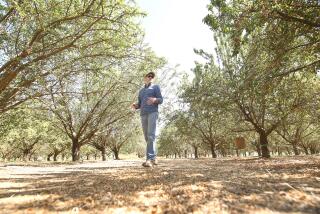Bug Money : Farmer Makes Big Profit Raising Insects That Devour Citrus Predator
- Share via
Reed Finfrock of Fillmore has realized a lifelong goal, to own his own farm. His four-acre Grand Avenue spread is a bug farm.
Finfrock and his wife, Jan, raise Aphytis melinus , a tiny insect that preys on a common citrus pest called red scale.
The operation seems worlds apart from tending a herd of dairy cows or a grove of fruit trees. But far from driving him buggy, Finfrock’s Sespe Creek insectary feeds a fascination with insects that began “as soon as I was old enough to carry a butterfly net.”
The beneficial bug business has proved profitable as well. Citrus growers statewide constantly battle the red scale pest, which scars fruit and can damage trees. Diminutive winged Aphytis melinus is so successful in controlling red scale that “the demand is going through the roof,” Finfrock said.
This year, the insectary is shipping an average of 1.75 million bugs a day to customers from Riverside to Tulare counties, nearly double 1989 production.
Farming miniature “livestock” has its advantages. Instead of rows of outdoor pens, the Finfrocks house their charges in a temperature-controlled room, where millions of the insects mature in specially designed wooden cabinets. It’s a tidy and compact arrangement.
To feed the Lilliputian predators, the Finfrocks raise ivy scale, a less virulent cousin of the red scale. Cultured on banana or acorn squash, the ivy scale is grown in its own air-conditioned building. When mature scale covers the squash, it is carried to the predator room. In Jan Finfrock’s estimation, the operation uses 50 tons of squash annually.
The critters of Sespe Creek are too numerous to name or number. But Finfrock, whose background includes a degree in biology from the University of Redlands, is intimately familiar with every phase in the life of the little bugs.
“The female does this kind of dance,” Finfrock said. “It actually measures the scale, decides how many young it can support and lays that many eggs.”
In the next two weeks, the young devour the soft inside of their scaly host and emerge, ready for harvesting. No picking crews or giant combines are required; while still in a drawer with the squash, the adult flies are dosed with carbon dioxide to immobilize them.
The harvesting table resembles a chemistry lab. Graduated cylinders are used to measure the number of inert insects as they are counted out and dumped into quart containers.
About 50,000 bugs go into every quart container that the Finfrocks use in delivering the insects to their customers. The containers, which sell for $35, are also temperature controlled, since the pampered predators are sensitive to extreme temperature.
Similar methods are used by Ventura County’s two cooperative insectaries, which serve citrus protective districts in Fillmore and Santa Paula. The only other commercial insectary in the county, Rincon-Vitova, specializes in fly and aphid control.
To run the self-styled “mom and pop” operation, the Finfrocks rise before dawn seven days a week during the February to October insect-growing season, and often work 10-hour days. Finfrock dreams of giving up the delivery route and hiring additional help. But even bugs are risky business, and he hesitates to predict the future.
Like any farmer, “We’re at the mercy of the weather and the market,” Finfrock said.
More to Read
Inside the business of entertainment
The Wide Shot brings you news, analysis and insights on everything from streaming wars to production — and what it all means for the future.
You may occasionally receive promotional content from the Los Angeles Times.










